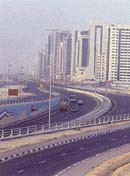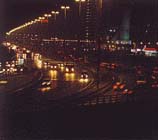
|
|
The creation of the master plan itself was a complex process that involved dividing the city into 22 communities and studying each one in detail. This involved surveying its socio-economic structure, the population density, road usage and most importantly, its trip generation. With the trip generation, the study found out how people travel in a certain community, their travel behavior and form of transportation. As in most urban areas, a large part of the community are what Saeed describes as 'pendulum travellers'. These are usually office goers who have a daily specific route to go to the office and back. Added to this information is the traffic factor for each community.
Perhaps the most complex part of the study was dealing with the twin problems of population and vehicle ownership. These are variable as a large percentage of the population is made up of expatriate workers who's numbers vary according to the economic climate and thus to some extent affecting car ownership. Having said this the national survey conducted in 1995, showed the population as 650,000 and growing rapidly. Current official estimates place the figure for Dubai's population in 2010 at 2.2 million. "Our primary plan is to upgrade the existing 4,000 kms of paved roads," said Saeed. "And since we decided on a free flow system rather than a grid system for smooth traffic flow, our priority was safety, a major concern in the design of any road system." The move to a free flow system means that many of the city's roundabouts will be replaced with signal junctions and two-tier roads (ground level road and bridges). "Junctions can carry twice the volume of traffic as roundabouts," explains Saeed. "Which is why we replaced roundabouts with junctions in busy city areas. But there are places where roundabouts are better and safer, mainly in low traffic areas. In a low traffic area, because of the sparse traffic some motorists are tempted to jump red lights at high speed often causing collisions in which people can be seriously injured, sometimes fatally. A roundabout, on the other hand, forces drivers to slow down." Moreover, as Saeed points out, roundabouts are much better for landscaping and aesthetics.
"Originally, we had two types of asphalt," says Saeed. "One was Asphalt Concrete (AC), which has finer aggregate in it, giving a less resilient surface that is suitable for low volume traffic. The second type is Dense Bitumen Macadam (DBM). This is good for heavy vehicular flows, but was rougher and had a shorter life. The new surfacing material is of the bitumen type. One of the things we have done is reduce the bitumen content to combat heat." Also, where the water table is high, the new road design places in a filter layer of aggregate or uses membranes, to solve the problem. This has been done on Sheikh Zayed highway connecting Dubai and Abu Dhabi.
The lifespan for the new roads is listed at 20 years and the Municipality's Pavement Management Crew and Maintenance Divisions will be checking to see just how far that can be increased. "Many a time, with the correct preventive and corrective maintenance, the lifespan of a road can be increased tremendously, sometimes even doubling it," says Saeed. Most of the roads in Dubai though are kept in very good condition and the municipality plans to replace the older roads with the new design once their lifespan is completed. The technical aspects of developing the road systems here have also encompassed the re-engineering of the traffic flows of the Central Business District (CBD). "With the CBD, we had no way to increase the size of the roads or re-design them because of the limitation of space", says Saeed. "What we did then was to manage and change the traffic flows around the five blocks making up the area." Part of tof the solution was the introduction of a parking meter system, something that has found little favour with residents. Saeed however, sees the meters as being a good thing. "Earlier, you had to drive round and round searching for a parking spot and often got blocked in by people double parking, wasting your time and causing a great deal of frustration. The advent of the ticket systems has discouraged people from leaving their cars all day in the same spot or blocking in other people. Now you just get the ticket and can find a space almost immediately." Phase one of the master plan, currently underway, is estimated to be costing Dubai Municipality Dhs1.5 billion, approximately US$407 million. Later this year, the construction of a new 40 km ring road will get under way to connect Sharjah, Dubai and Jebel Ali. The project, designed by the American firm of DeLeuw Cather International is expected to cost Dhs 300 million (US$81.4 million). Another project expected soon is the extension of Sheikh Zayed highway to make it eight lanes all the way to Abu Dhabi, estimated to cost Dhs 130 million. Phase Two, says Saeed, will begin around the year 2000 and will study the possibility of building another bridge across the creek. Alternatively upgrading the present Al Garhoud bridge or Shindagah tunnel may be a possibility, but based on the present 10% increase in traffic annually, it would seem that the bridge is the more likely solution. Phase Two will also see new junctions being added to the existing network. At least the Municipality will not have trouble securing the land for the roads. "Road corridors have been allowed for in the city plan, so we rarely have problems in securing the land," says Saeed. "Occasionally, we do have to pay compensation for private land that is used." One of the most remarkable aspects of Dubai is that it is ever evolving so there is no sense of complacency in the City Planning Department. As Saeed remarks, "The physical growth of the city is amazing. The boundaries are constantly being pushed back. An area like Garhoud for instance, was almost the city's southern limit five years ago. Today it is close to the heart of the city." If that remains the case, the Roads Department at least, will have their hands full right through to the next millenium.
|
Fergi Varghese
|

 ince the late 1980s, Dubai has been enjoying a boom in construction. That in an ever expanding city such as Dubai, may not be very newsworthy. But what was different about this boom it that it's main areas of growth are in infrastructural projects. And a key part of any infrastructural plan is the development of a comprehensive road network to allow people and goods to move quickly from one part of the country to another.
ince the late 1980s, Dubai has been enjoying a boom in construction. That in an ever expanding city such as Dubai, may not be very newsworthy. But what was different about this boom it that it's main areas of growth are in infrastructural projects. And a key part of any infrastructural plan is the development of a comprehensive road network to allow people and goods to move quickly from one part of the country to another. " In 1990, we appointed a consultant (Dar Al Handasah) to study and create a transportation master plan for Dubai," says Nasser Ahmed Saeed, director of the roads department at Dubai Municipality, the road network authority in the Emirate. "This master plan covers our transportation needs upto the year 2010, with reviews every five years to ensure we are still on track and fufilling the plan."
" In 1990, we appointed a consultant (Dar Al Handasah) to study and create a transportation master plan for Dubai," says Nasser Ahmed Saeed, director of the roads department at Dubai Municipality, the road network authority in the Emirate. "This master plan covers our transportation needs upto the year 2010, with reviews every five years to ensure we are still on track and fufilling the plan."  "Once this data was collated, we used a computer programme called Saturn to create a model which could forecast traffic and its impact on every road in the emirate," explains Nasser Saeed. "We wanted a system where one could travel between any two points in the city in 25 minutes maximum. So we decided on a free flow system to achieve this."
"Once this data was collated, we used a computer programme called Saturn to create a model which could forecast traffic and its impact on every road in the emirate," explains Nasser Saeed. "We wanted a system where one could travel between any two points in the city in 25 minutes maximum. So we decided on a free flow system to achieve this." In redesigning the road system, what has changed is the technical specifications for the new roads in the plan. Some of the major problems here are high atmospheric salinity, heat, high water tables and using the AS and BS designs. These have lead to unsatisfactory results in terms of longevity and strength. According to Saeed, "To ensure the specifications for the new roads we sought the help of specialists. It took us over four years, from 1985 to 1989, to get it right. Other than salinity, the water table and heat, the other major problem was that our roads have to be designed for an unlimited load restriction. Which means that any number or kind of vehicle can travel on them." The trick was to come up with a special material and a special way to treat concrete to give it greater strength.
In redesigning the road system, what has changed is the technical specifications for the new roads in the plan. Some of the major problems here are high atmospheric salinity, heat, high water tables and using the AS and BS designs. These have lead to unsatisfactory results in terms of longevity and strength. According to Saeed, "To ensure the specifications for the new roads we sought the help of specialists. It took us over four years, from 1985 to 1989, to get it right. Other than salinity, the water table and heat, the other major problem was that our roads have to be designed for an unlimited load restriction. Which means that any number or kind of vehicle can travel on them." The trick was to come up with a special material and a special way to treat concrete to give it greater strength. Sheikh Zayed road was also the site of an unusual accident when a section of the eight lane highway collapsed due to pressurised water surging from the underground water main crossing it. "To prevent this sort of thing happening again, we have designed culverts," says Saeed. "Now all pressured services like water and gas must go through the culverts to prevent a surge." The new designs have also won praise from road contractors: "The good thing is that there is an awareness of the demanding local conditions with codes being developed to suit the environment," says John Papadouris, general manager of UTCC Wade Adams.
Sheikh Zayed road was also the site of an unusual accident when a section of the eight lane highway collapsed due to pressurised water surging from the underground water main crossing it. "To prevent this sort of thing happening again, we have designed culverts," says Saeed. "Now all pressured services like water and gas must go through the culverts to prevent a surge." The new designs have also won praise from road contractors: "The good thing is that there is an awareness of the demanding local conditions with codes being developed to suit the environment," says John Papadouris, general manager of UTCC Wade Adams.